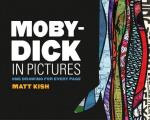
Finishing was the hardest part. When I began, I identified quite a bit with Ishmael. Here was this man who had been struggling with a November in his soul and decided it was high time he set sail and see the world a bit. Ishmael is a cipher, a non-entity, whose only role is to tell the tale. I would, in my own way, be re-telling the tale of
Moby-Dick with my drawings. Who I was didn't matter and my part in the journey would be small. Just as the story itself is what mattered, my drawings were the only thing I thought should matter.
That perception suited me well, particularly for the first half of the project. Although it was at times trying to force myself to be as visible and accessible as the requirements of the blog and the new book demanded, I was always able to retreat back into a life of privacy and obscurity. In the beginning especially there was still some time each day to sit down and talk to my wife, read another book, or take a walk.
As time went by and the events of the book edged closer toward their nihilistic climax and my involvement with the art became deeper and more demanding, I found myself changing. Often in ways I could never have predicted, and sometimes in ways that were abhorrent to me. Instead of feeling like Ishmael, a simple passenger on the voyage whose role it was to recount the events to those interested, I began, as cliché as it may seem, to identify more and more with Ahab.
It's interesting to note that my first drawing of Ahab was crisp, precise, pristine, and rendered primarily in cool nautical grays and blues. That, I suppose, is much how I felt at the time. As the months rolled by though, Ahab's madness seemed to claim me as well. My drawings of him became looser, sloppier almost, more and more unhinged. The formerly strict and orderly captain was showing his true colors as a revenge-obsessed monomaniac willing to push himself and his crew to any length to achieve his goal.
The project now had a deadline. A contract had been signed. And I was still working more than 40 hours per week and spending at least three hours every day in the car. Time was shrinking, dilating, until the lack of it nearly asphyxiated me. And yet, night after night after night, through the dimming days of fall and the icy nights of winter, I spent time with this book. With this captain and his madness. Finding, somehow, images inside of me to put down on paper.
The project nearly devoured me. I found myself thinking about the art incessantly. Every single second I could spare, every single second that I didn't spend working, driving, sleeping or eating I spent in the closet studio drawing or thinking about drawing. I began to build walls, pushing people away, seeing them as hindrances to what I really needed to be doing.
It was a difficult time for me. And then, so suddenly that it took me by surprise, I was finished. See, I would never let myself look ahead. I knew that to do that, to start counting the pages to the end, would be to rob what I was doing of the kind of urgency and energy that I needed. So, much like the sailors and harpooneers on the Pequod, I took each day as it came and thought nothing of yesterday or tomorrow. And, I suppose, much like the sailors and harpooneers on the Pequod, the end arrived quickly, suddenly, and with very little warning.
I had known what I wanted to draw for that last page for almost 18 months, so in some ways, this was the easiest image to create. But in so many more ways, it was the hardest. It was finally over, and while I was overjoyed to have my own life back, to have the kind of freedom that had been missing from my life for a year and a half, it was bittersweet. I had spent so much time with this story and these characters that their absence left a hole inside me. Even in the darkest, most desperate, most solitary hours in the studio, I still walked with Ahab and Queequeg and Starbuck. And now they were gone. But the work was finished, and the drawings remained. And of that, I was very proud.

Looking back, I have no regrets. I will not read Moby-Dick again for some time, but I will read it again. I would never choose to experience something like this again, but I think it is right that I did. While I have gained much from this — a deeper understanding of Moby-Dick, the most personal and intimate reading of a book I have ever journeyed through, an art book full of my own drawings, a body of art that I am immensely proud of — what I value the most is what I learned about myself and about people. I went from almost total solitude to a place of being more connected, in more ways, with more people than I would have ever realized. Being able to share this art and this journey with so many people, through interviews, blogs, videos, and the book itself, has been an experience that will continue to shape me for decades, and one I'll never forget or take for granted.